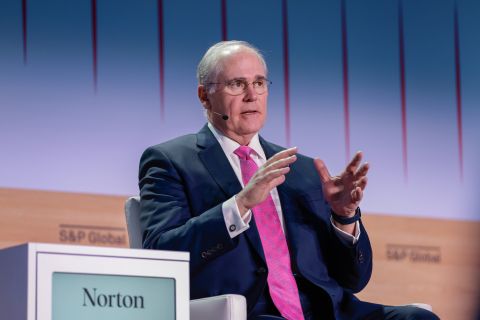Thank you for joining us. I'm Nissa Darbonne, executive editor-at-large with Hart Energy. I'm visiting with Bernadette Johnson. Bernadette is General Manager, Power and Renewables for Enverus and has been an at least 20-year veteran of oil and gas industry data mastering.
ND: Thank you for joining us, Bernadette. I wanted to talk to you about natural gas prices, in particular, just the fact that the extra 500 Bcf that we have in storage coming out of winter right now is literally the 500 Bcf that Freeport LNG did not export beginning last June until it came back online late this February. Still, it's real. There are 500 Bcf, too many, in storage right now. How are we going to get rid of this?
Bernadette Johnson, general manager of power and renewables, Enverus: I would point to the natural gas market, especially in the U.S. Even though we're part of a global market, it's one of the most pure markets—we study it in economics. So everything that's happening today, with lower prices, because there's a storage overhang, and relatively higher production, this is actually the market working. So this is a good thing; this is to be expected. Now how do we get rid of it? Well, Freeport is back online. That's certainly going to help. You have some incremental demand that's growing, not just LNG, in the midterm, or short-term, I'll call it. But you also have power demand expected to grow this summer. You also have industrial demand that's growing. You have exports to Mexico that are growing. So you have this underpinning demand that's growing. So that's going to help. It means we're not going to put as much in storage as we march through the summer.
But today we're at an inflection point. There's two natural inflection points for gas. It's every spring and every fall—whatever price needs to do in the spring so that you don't blow through storage at the end of the season is exactly what it does. It's exactly why we have price pressure today. So it's a short term thing. Price drops, pull some supply out of the market where it causes drillers to go a little more slowly so we don't continue to grow production. We get to the end of the season, we're at full storage again heading into the next winter. As long as winter shows up, we're back in equilibrium. Right? We're back into a healthy market. So I think the last thing I'll add is, these markets, you can see very heavy or significant price swings one way or] another]—up or down—either direction, if the market is out of balance by just a few percent. And so that's what's happening. The 500 Bcf sounds like a huge number. It's not a huge number relative to the overall gas market.
ND: True. Two Bcf/d that Freeport exports in comparison to roughly 100 Bcf/d of overall U.S. natural gas demand.
BJ: Exactly. It's five days of production, right? So that sounds like a lot. And today it is, but it won't be for long.
ND: Yeah, [when] you look at it in that perspective, that's quite large—an accumulation of 2 Bcf/d. You mentioned Mexico, and I want to talk to you about China too. Let me start with China. With China reopening, is that potential additional draw, and in terms of competition with Europe for our LNG, could that help natural gas prices?
BJ: Anything that is supportive for demand will help natural gas prices. But I will also say—it’s a timing issue. So could we send out as much LNG as the world demands right now? We can't. We're waiting on additional LNG terminals to show up, to be built, to get through permitting, to actually start first send out. And so that's one thing. This is a timing issue. So would that help us in the next year? No. Does that help us continue to fill LNG terminals as they start coming online, starting next year essentially, and then beyond? Yes. And there's a ton of capacity that's slated to be built between now and the end of 2027. If you add it all up, if today we're sitting at about 12.6 Bcf/d of capacity, it's over 26 Bcf/d by then, potentially. And so that's a good thing. And we'll need additional demand because of open markets in Europe and Asia, really all around the world, if we're going to fill those terminals. So again, anything that is supportive for demand helps gas prices, but maybe not immediately. But 2024, mid-2024 plus, we're pretty bullish pricing, and that's a big part of it.
ND: Thank you, Bernadette. Thank you for joining us.
BJ: Thank you.
ND: Thank you. And please tune into Hart Energy LIVE for more expert insights, such as from Bernadette.
Recommended Reading
Elk Range Royalties Makes Entry in Appalachia with Three-state Deal
2024-03-28 - NGP-backed Elk Range Royalties signed its first deal for mineral and royalty interests in Appalachia, including locations in Pennsylvania, Ohio and West Virginia.
Marketed: Private Seller Certain Royalty Properties in D-J Basin
2024-02-13 - A private seller retained RedOaks Energy Advisors for the sale of certain royalty properties in the D-J Basin.
Civitas, Prioritizing Permian, Jettisons Non-core Colorado Assets
2024-02-27 - After plowing nearly $7 billion into Permian Basin M&A last year, Civitas Resources is selling off non-core acreage from its legacy position in Colorado as part of a $300 million divestiture goal.
ONEOK CEO: ‘Huge Competitive Advantage’ to Upping Permian NGL Capacity
2024-03-27 - ONEOK is getting deeper into refined products and adding new crude pipelines through an $18.8 billion acquisition of Magellan Midstream. But the Tulsa company aims to capitalize on NGL output growth with expansion projects in the Permian and Rockies.
EIG’s MidOcean Energy Acquires 20% interest in Peru LNG
2024-02-08 - On top of acquiring a 20% interest in Peru LNG, MidOcean Energy is also in the process of acquiring interests in four Australian LNG projects.





